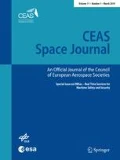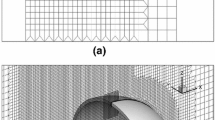Abstract
The axisymmetric concave body is a typical configuration about which shock/shock interactions appear. Various shapes of axisymmetric concave bodies are used in a variety of applications in aeronautics, for example, axisymmetric jet inlets with conical centerbody, ballistic missiles drag reduction by spike, plasma or hot gas injection, parachutes for pilot-ejection capsules. However, it is well known that two distinct modes of instability appear around a concave body in the high-speed flow regime for a certain range of geometric parameters. These instabilities can cause undesirable effects such as severe vibration of the structure, heating and pressure loads. According to the experimental evidence, the unsteady flow is characterised by periodic radial inflation and collapse of the conical separation bubble formed around the forebody (pulsation). Various explanations have been given for the driving mechanism of the instabilities. In the present, merging of the leading explanations is done, and basic rules for the passive suppression of the instabilities are applied, in order to enforce their proposed driving. In addition, the effect of the flow initialisation method on the flow structure predicted by numerical simulations is examined. For certain configurations, bifurcation of the time-dependent flow has been found. This behaviour is explained with recourse to the phenomenon of hysteresis, which is an inherent feature of the examined flows.












Similar content being viewed by others
References
Edney, D.: Anomalous heat transfer and pressure distributions on blunt bodies at hypersonic speeds in the presence of an impinging shock. FFA Rept. 115 (1968)
Feszty, D., Badcock, K.J., Richards, B.E.: Driving mechanisms of high-speed unsteady spiked body flows, Part 1: Pulsation mode. AIAA J. 42(1), 95–106 (2004)
Holden, M.S., Wandhams, T.P., Harvey, J.K., Candler, G.V.: Comparisons between DSMC and NS solutions and measurements in regions of laminar shock wave boundary layer interaction in hypersonic flows. AIAA P-2002-0435 (2002)
Panaras, A.: Pulsating flows about axisymmetric concave bodies. AIAA J. 9, 804–806 (1981)
Yee, H.C.: Building block for reliable non-linear numerical simulations. In: Drikakis, D., Geurts, B. (eds.) Turbulent Flow Computation. Kluwer, Dordrecht (2001)
Panaras, A., Drikakis, D.: High speed unsteady flows around concave axisymmetric bodies: flow instabilities and their suppression. In: 6th European Symposium on Aerothermodynamics for Space Vehicles, Versailles, ESA-SP-659 (2009)
Panaras, A., Drikakis, D.: High speed unsteady flows around spiked blunt-bodies. JFM 632, 69–96 (2009)
Wood, C.: Experimental flow over spiked flows. JFM 12, 614–624 (1962)
Kabelitz, H.: Grenzschichtabloesegebiet an konischen Drehkoerpern bei Hyperschallstroemung. DLR FB 71-77, 1 (1971)
Morrison, J.H.: A compressible Navier-Stokes solver with two-equation and Reynolds stress turbulence closure models. NASA CR-4440 (1992)
Panaras, A.: The high speed unsteady separation around concave bodies can be explained by an inviscid flow mechanism. These Annexe, VKI-Free University of Brussels (1976)
Feszty, D., Badcock, K.J., Richards, B.E.: Driving mechanisms of high-speed unsteady spiked body flows, Part 2: Oscillation mode. AIAA J. 42(1), 107–113 (2004)
Candler, G.V., Nompelis, I.: Computational fluid dynamics for atmospheric entry. In: VKI, Lecture Series on Hypersonic Entry and Cruise Vehicles (2008)
Panaras, A.: Pressure pulses generated by the interaction of discrete vortices with an edge. JFM 154, 445–462 (1985)
Panaras, A.: Shear layer-edge interaction: simulation by finite area vortices. AIAA J. 28(9), 1557–1564 (1990)
Ganiev, Y.C., Gordeev, V.P., Krasilnikov, A.V., Lagutin, V.I., Otmennikov, V.N., Panasenko, A.V.: Aerodynamic drag reduction by plasma and hot-gas injection. J. Thermophys. Heat Transf. 14(1), 10–17 (2000)
Elias, P.-Q., Chanetz, B., Coponet, D., Benay, R.: Mach-3 shock wave unsteadiness alleviation using a negative corona discharge. AIAA P-2000-3570 (2000)
Kenworthy, M.: A study of unstable axisymmetric separation in high speed flows. PhD dissertation, Department of Aerospace and Ocean Engineering, Virginia Polytechnic Institute and State University, Blacksburg (1978)
Author information
Authors and Affiliations
Corresponding author
Rights and permissions
About this article
Cite this article
Panaras, A., Drikakis, D. Physical and numerical aspects of the high-speed unsteady flow around concave axisymmetric bodies. CEAS Space J 1, 23–32 (2011). https://doi.org/10.1007/s12567-010-0001-7
Received:
Revised:
Accepted:
Published:
Issue Date:
DOI: https://doi.org/10.1007/s12567-010-0001-7




